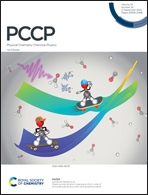Tunable magnetocrystalline anisotropy of two-dimensional Fe3GeTe2 with adsorbed 5d-transition metal
Abstract
The demand for ultra-compact spintronic devices with lower energy consumption and higher storage density requires two-dimensional (2D) magnetic materials with tunable magnetocrystalline anisotropy (MCA) energy. Employing first-principles calculations, we have investigated the influence of W atom adsorption and biaxial strain on the magnetic properties of layered Fe3GeTe2. We demonstrate that the adsorption mode and applied strain play a critical role in determining their MCA. The Fe3GeTe2 adsorbed with W atoms undergoes a change in spin reorientation from out-of-plane to in-plane magnetization, yielding a colossal MCA up to −13.112 erg cm−2. The dominant contribution to these unexpected changes mainly arises from the W atoms with emerged magnetism and large SOC. Moreover, our results reveal distinct strain-driven modulation behaviors of the MCA in different adsorption configurations. The underlying atomistic mechanism mainly involves the alteration of various W-derived 5d-orbital states under the strain effect, leading to competitive changes of the corresponding spin–orbit coupling energies between the spin-parallel and spin-flip channels. Our findings not only provide useful guidance in optimizing the MCA performance of 2D magnetic crystals but also highlight the potential of W-adsorbed Fe3GeTe2 in the applications of new-generation magnetic memory storage devices.



 Please wait while we load your content...
Please wait while we load your content...